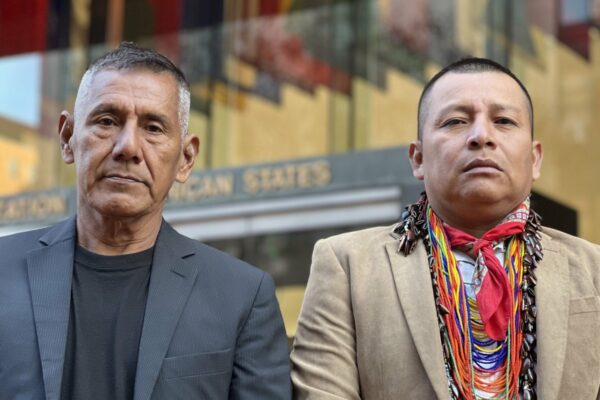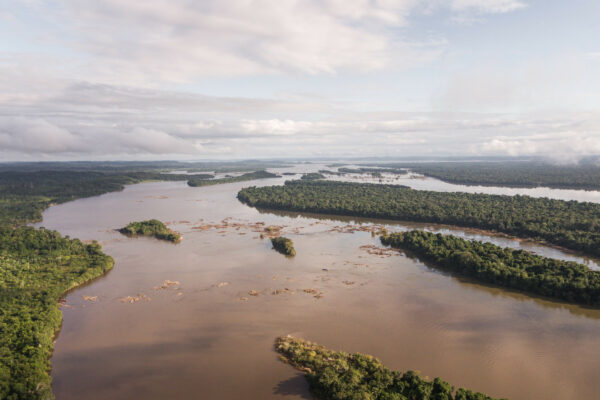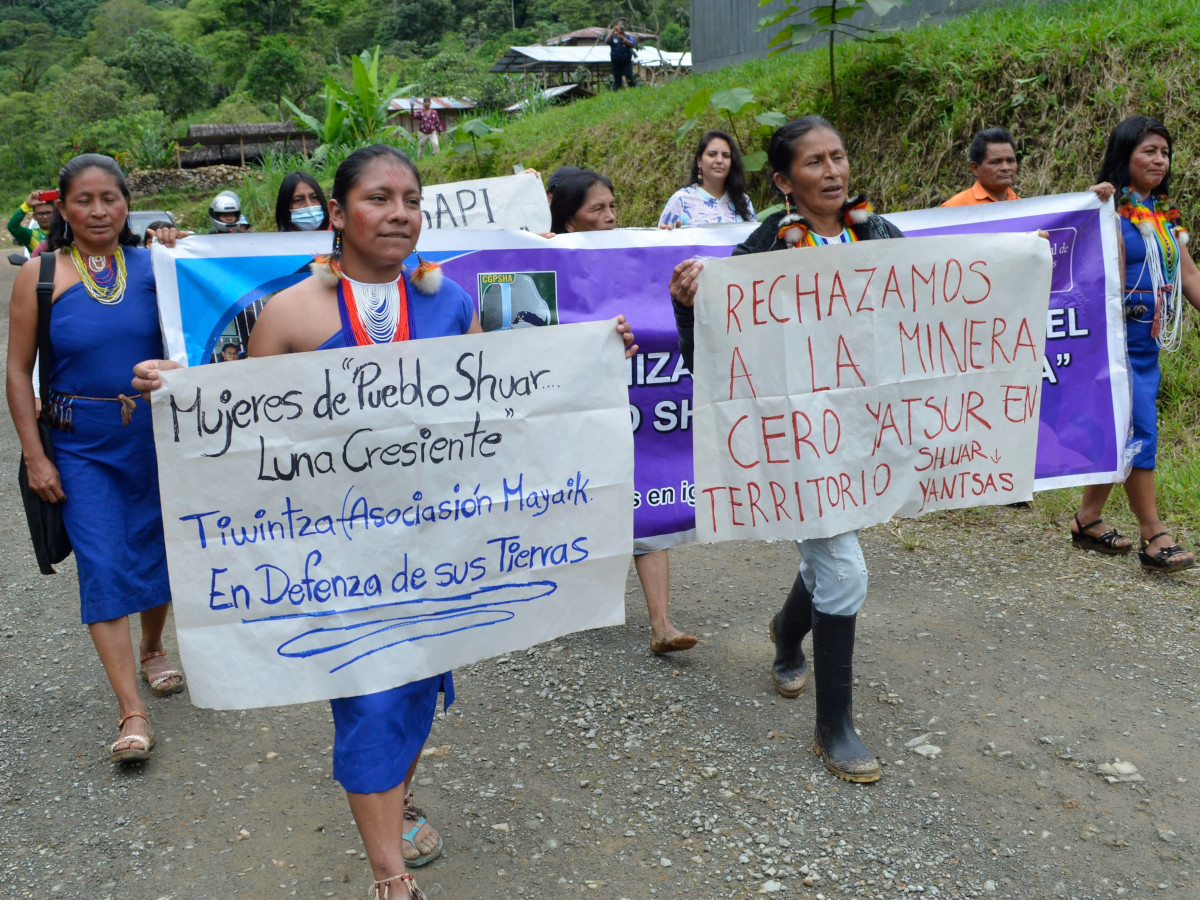
Indigenous communities in Ecuador celebrated this week after President Lenin Moreno announced Monday that the government would come down harder on oil and mining companies that don’t comply with the country’s social and environmental laws.
New mining concessions are now stalled until the companies can prove they’ve complied with all regulations under the constitution. This includes Article 57, which states that indigenous groups have the right to free and prior consultation before extractive projects take place near their land.
This was just one of the agreements President Moreno reached with the Confederation of Indigenous Nationalities of Ecuador (CONAIE), the country’s largest indigenous organization.
Indigenous groups like CONAIE and the Confederation of Indigenous Nationalities of the Ecuadorian Amazon (CONFENIAE) seemed content with this new agreement, even though both groups had previously firmly demanded that oil and minerals stay in the ground and that extraction activities in the Amazon stop immediately.
Moreno’s announcement came after his government started receiving more pressure from indigenous groups, demanding it respond to concerns they raised over five months ago.
One of these pressures came in the form of a massive protest on Monday. Over 3,000 indigenous people from across the country gathered in front of the presidential palace in Quito, and banged drums, chanted and shouted anti-government slogans for almost six hours. Most of those present were indigenous nations from the Amazon rainforest, but people came in from all over the country, and included the Shuar, Achuar, Huaorani, Quichua, and Zapara nationalities, among others.
Many carried large hunting spears, wore face paint and dressed in traditional clothing, proudly displaying all elements of their indigenous culture in the capital city. One man from the Amazon even walked around with a live boa constructor around his neck.
The diverse group of protesters had various demands for the government, ranging from protecting the Amazon, land reforms, water rights, education, health care and amnesty for rights defenders.
“I’m fighting for the students. The other government closed the schools in the communities and made these millennials schools… but we want schools in the communities,” said one Achuar protester who identified herself only as Luisa. “And Yasuni,” added Luisa, referring to one of the most biodiverse regions in the Amazon rainforest, and a hot spot for oil.
“Keep the oil in the ground,” she added.
Close talks
Throughout the day, the president gradually invited specific indigenous leaders into the presidential palace, otherwise known as the Carondelet, to speak directly with him and various ministers about their concerns.
While protesters continued to make noise outside, the leaders took on a meeting that lasted almost four hours. What resulted was a deal to temporarily stop new mining concessions, but the government also promised to build programs for bilingual education, support land restitution for certain select communities, and said there was a potential for state support for rural transportation.
It’s unclear what, if anything, was decided for other major concerns that the indigenous communities brought with them, such as amnesty and pardons for rights defenders and tackling political corruption.
In a tweet late Monday night, CONAIE President Jamie Vargas thanked the “bases of the (indigenous) nationalities and people of Ecuador for the great day of national mobilization that allowed us to reach several agreements.”
But it’s unclear if the agreements were widely accepted by Ecuador’s diverse indigenous communities, who seem to be demanding more substantial changes. In Monday’s protest, many held signs that read things like “These lands are ours, united we will overcome,” and “We demand justice” and “The Amazon jungle cannot be sold, it’s sacred indigenous territory.”
Franco Chumpi, Vice President of the Shuar Federation (FICSH) in the southern Amazonian province of Morona Santiago. It is an area the Ecuadorian government has long promoted as a hot spot for future mining investments. In the last couple of years, several Shuar communities from the area have been displaced, or are currently undergoing land battles for the sake of large mining projects such as the communities of Nankits and Warints.
Chumpi said he has long been fighting with the government to improve these conditions, but “While we keep talking, they keep operating,” he said.
Long-term momentum
Though the protest culminated in Quito Monday, it had long been building steam across the country.
Over two weeks ago, over 300 indigenous people gathered in the Amazonian city of Puyo, and set off on foot to Quito, some 154 miles away, to join the protest. They took off on November 27th, and walked about 10-20 miles a day, marching through rain and blistering heat, protesters told Mongabay. During the day, they took few breaks and subsisted mainly on chewing sugar cane and drinking chicha, a fermented beverage made from masticated yucca and a staple food for the Amazonian communities.
“It was hard, especially for the mothers who came carrying their children,” protester Luisa said. “But we came yelling, and dancing, and that gave me a lot of joy.”
The act of walking was meant to raise national awareness of the plight of the indigenous people of Ecuador, but it was also a symbolic move in memory of their ancestors, who walked long distances without cars or the need for petroleum. Several participants referenced a similar march in 1992, when over 500 indigenous people walked the same route from Puyo to Quito, demanding the government recognize their territorial rights.
“In 1992, our elders also marched,” said CONFENIAE President Marlon Vargas at a press conference the day before the government announced its new agreements. “They didn’t need buses or cars. So after 25 years, we returned to this historic fight, and to say no more extractivism.”
The group arrived in Quito on December 9, after thirteen days of walking. They amassed with the other protesters on December 11, when they continued their final leg of the journey to the presidential palace.
Moreno’s national dialogue
The controversy with the new government of Lenin Moreno had been brewing for a few months, with indigenous communities demanding “a dialogue with results.”
Earlier this year, the newly elected Moreno government invited the leaders of CONAIE to participate in a dialogue on how to improve conditions for indigenous communities in the country. The move was part of Moreno’s new plan for a National Dialogue, to engage various sectors of civil society in discussing the country’s future.
The president and various ministries met with CONAIE on July 4, and then again on September 11, when the organization presented a list of the indigenous communities’ main demands.
Among these were bilingual education programs, strengthening community transportation, rehabilitating the territories of indigenous communities displaced by mining projects, promoting food sovereignty, incorporating indigenous peoples in discussions about mining or oil extraction, amnesty for rights defenders and keeping oil and minerals in the ground.
Indigenous communities initially supported the idea of a dialogue, especially after feeling shunned by the last government of Rafael Correa, who was notorious for shutting down dialogue with social movements and civil society groups.
But five months after the first meeting with Moreno, the government showed no signs of moving forward on any of the issues they spoke about. Trust in the state began to wane once again, and various indigenous factions began to organize to demand results.
Since the protest on Monday, Moreno has agreed to some version of some of CONAIE’s initial demands, but has not responded publicly about the others.
At the time of publication, three government ministries (the Ministry of Hydrocarbons, Ministry of Mining, and Ministry of Policy Management) had not returned several requests for interview.













